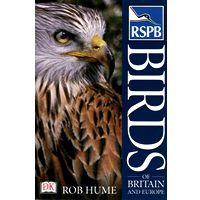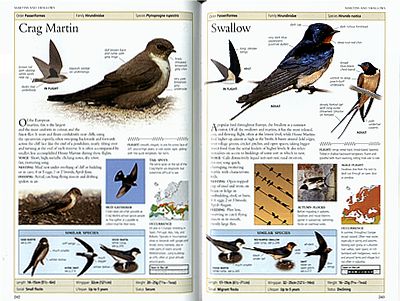RSPB Birds of Britain and Europe by Rob Hume
In the same week that we received the new RSPB Handbook of British Birds from Helm, we also had the new revised version of the RSPB Book of British Birds (Holden and Sharrock) and this new 'RSPB' guide from Dorling Kindersley. Like number 9 buses, none for a couple of years then 3 in a week! The thing that's new about this DK version is that it looks very much like a typical field guide in format but the 'illustrations' for each species are mostly photographs. In typical DK fashion, the images have been cut out from their backgrounds and pasted onto a clean white page. In this case, each species is given a page of its own and, where several plumages need to be shown, the publishers have found the most suitable photos and pasted them in appropriately. The identification features shown by each photo are pointed out using lots of annotations. The overall outcome is something that looks like the Larousse/Kingfisher field guide but with photos where the paintings would be. |  |
As you might expect from DK, the finished book looks very attractive and they've certainly done a good job of finding photos of almost every species, and lots of plumages, all in classic textbook poses. They've also had the wisdom to use a good birder, Rob Hume, to write the texts and the captions ensuring that the information provided is accurate and reliable. So far, so good then - but for all its good points this is a book that I suggest shouldn't be the first-choice guide for a birdwatcher at any level.
Why? Well, to me this looks like a book that's been published by non-birders (DK, not the RSPB) who don't really know their market. A keen birder might want a book like this because of the potential of having a collection of photos of birds in different plumages for reference purposes. However, its usefulness in this respect is severely limited by the fact that only 320 species are given the 'full-page' treatment with several photos. Even birds as common in some parts of Europe as Thrush Nightingale, Red-crested Pochard, Olivaceous Warbler and Black-headed Bunting have been relegated to a section at the back of the book in which they each have only a quarter of a page and one photo. Keen birders will be frustrated to find that almost all the rarer species they're most interested in have been given this superficial and disappointing treatment. Hence as a photographic reference it's not as good as the Hamlyn Photographic Guide (Delin and Svensson) published 14 years ago, and as a field guide it's nowhere near as effective as the Collins Bird Guide (that man Svensson again).
Ok, well maybe this isn't aimed at keen birders. But surely novice birdwatchers would either want a really good identification guide or a book that provides them with lots of other interesting information about each species. The 'general knowledge' aspect isn't covered anything like as well here as in the new RSPB Handbook and sadly, from a beginner's point of view, I don't think it works very well as an identification guide either, for four reasons.

Firstly, the format of one species per page means you can only see two species side-by-side and often the birds aren't paired with the most appropriate species. The designers have tried to counter that by having a panel on each page, showing up to 3 'similar species', with simple annotations to point out the differences. This is definitely useful but the images are too small and the text too brief to solve any but the most simple identification issues.
Secondly, most of Rob Hume's text is taken up with descriptions of the habits and habitats of each species, so the only way to learn the differences between species is in the annotations on the photos. This is fine (they're certainly well written) but you lose all sense of priority when a photo has 4 or 5 captions. Yes, these are all differences, but which are the most important? Rob hasn't been given the opportunity to explain how to separate any species so his knowledge has been only partly passed on.
Thirdly, although this is a matter of opinion, I firmly believe that the most instructive way to illustrate the differences between any two or more species is to use paintings. Gone are the days when field guides had rubbish artwork that didn't actually look like the birds in question. Today's artists are so good that their work has the accuracy of photographs but without being complicated by the variables of light, distance or film quality that can make photos confusing. There are many photos in here that, for one reason or another, present an atypical image for that species - the main Icterine Warbler image is one striking example.
Lastly, the choice of species, although too limited for many birdwatchers, is also too extensive for beginners who can do without having to worry about Bonelli's Warbler, Middle Spotted Woodpecker, Marsh Sandpiper, Pallid Swift and Rock Sparrow.
Don't get me wrong, this is a good book, well written, attractively presented and full of really good photos. But keen birdwatchers would have liked a more comprehensive photographic reference and novice birdwatchers would have appreciated something simpler, giving them more help on how to identify the British species. It will make a fine addition to your bookshelf, especially if you value having about 2000 more photos as reference material, but it's not a 'must-have'.


